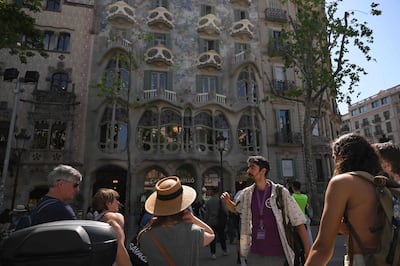Just in time for the summer travel rush, Dubai carrier flydubai is adding daily flights to Islamabad and Lahore. The airline already serves many Pakistani cities including Karachi, Faisalabad, Multan, Quetta and Sialkot.
Meanwhile, Oman’s low-cost airline SalamAir is ramping up its service to India, launching twice-weekly flights to Chennai in South India, in addition to its existing routes to Jaipur, Trivandrum and Calicut.
Here’s a round-up of recent travel and tourism news – in case you missed it.
Flydubai launches daily services to Lahore and Islamabad
Dubai carrier flydubai will fly daily to Pakistani cities Islamabad and Lahore from July 1.
Departing from Terminal 2 in Dubai, flight FZ353 will take off at 9.05am local time and arrive at Islamabad International Airport at 1.20pm local time. The corresponding flight, FZ354, will then leave Islamabad at 2.20pm local time, arriving in Dubai at 4.50pm local time.
Flights to Lahore’s Allama Iqbal International Airport, FZ359, will take off at 12.30am local time in Dubai and arrive at 4.45am local time in Pakistan. The return flight FZ360 will take off from Lahore at 5.45am local time, arriving at Dubai’s Terminal 2 at 8.15am local time.
Flydubai said the two routes will be served by its Boeing 737 Max fleet, offering both economy and business class seats.
Return economy fares to Islamabad start at Dh1,300, with business class starting at Dh5,500. For Lahore, return economy class fares start at Dh1,200, while business class seats start at Dh5,500.
Flydubai first started serving Pakistan in 2010 with flights to Karachi. The airline already flies to Faisalabad, Multan, Quetta and Sialkot.
SalamAir to fly twice weekly between Muscat and Chennai

Starting on July 11, Omani low-cast carrier SalamAir will operate two weekly flights between Muscat and Chennai in South India, on Thursdays and Saturdays.
SalamAir flight will depart Muscat at 11pm local time and arrive in Chennai at 4.15am local time. The corresponding flight will depart from Chennai at 5am local time and arrive in Muscat at 7.25am local time.
“We are thrilled to introduce our new service to Chennai, a significant milestone that enhances the connectivity of the South Indian community in Oman and the wider Gulf region,” said Harish Kutty, director of revenue and network planning for SalamAir. “With its rich cultural heritage and economic vitality, Chennai presents immense opportunities for residents, business and leisure travellers.”
SalamAir already operates regular flights to many India cities including Jaipur, Trivandrum and Calicut. The airline operates an all-Airbus fleet of six A320 Neos, six A321 Neos and one A321 freighter.
Why Barcelona is banning short-term rentals

Spain’s most visited city by tourists is planning to enact a citywide ban on all short-term rentals in a move to curb soaring rents.
Barcelona Mayor Jaume Collboni announced on Friday that the city will stop giving new licences and won’t renew existing ones. This means that by 2029, no homes will be allowed to be rented out to tourists. This will deal a massive blow to operators such as Airbnb.
“More supply of housing is needed, and the measures we’re presenting are to provide more supply so that the working middle class does not have to leave the city because they can’t afford housing,” Collboni said.
A total of 10,101 apartments currently have licences to operate, but will become void by 2028. Those apartments will be used by the city’s residents or will go on the market for rent or sale, Collboni said.
Barcelona already bans the rental of rooms to tourists, but that’s done little to reduce rents that have risen by 68 per cent over the past 10 years, the mayor said. The cost of buying a house also rose by 38 per cent during the same period.
Tourist hot spots such as New York, Tokyo, London, Amsterdam and Paris also have limitations on short-term rentals, but with varying degrees. Barcelona’s move is, however, one of the most aggressive restrictions to be put in place.
World’s most physically demanding attractions revealed

For travellers up for a challenge, UK gym chain PureGym has revealed its list of global landmarks that are most exhausting to experience. Scored on three main factors – the number of steps needed to experience it to its fullest, the total elevation change and the average daytime temperature – the attractions were then given an overall “exertion score” out of 100.
The Florli Stairs in Norway was ranked No 1, with a 76 exertion score. Also popularly known as Florli 4444, after the number of wooden steps required to climb it, this popular tourist attraction was built as a maintenance stairway for two water pipelines and a rail, which used to transport people and materials to the top of a mountain where a now-decommissioned hydro power plant sits. The 740-metre climb takes thee to four hours to complete.
In second place, with an exertion score of 63, is the Manitou Incline, a hiking trail in Colorado Springs in the US. The remains of a former railway track, the attraction has approximately 2,744 steps from the bottom to the summit, and is popular with fitness enthusiasts.
The Poenari Castle in Romania is in third place, with an exertion score of 58. Built on top of a mountain, it used to be the home of Vlad the Impaler, a national hero in Romania. Now in ruins, the castle is still a popular tourist site, and is accessed by climbing 1,480 concrete stairs.
At No 4 is the Konpira Shrine in Kagawa, Japan (exertion score 50), located at 521 metres halfway to the top of Mount Zozu. While Scotland’s Arthur’s Seat, the remains of an ancient extinct volcano which rises 250 metres, rounds up the top five, with an exertion score of 48.
Updated: June 24, 2024, 12:45 PM
